key PONTIAC GRAND PRIX 2007 Owners Manual
[x] Cancel search | Manufacturer: PONTIAC, Model Year: 2007, Model line: GRAND PRIX, Model: PONTIAC GRAND PRIX 2007Pages: 526, PDF Size: 2.92 MB
Page 1 of 526
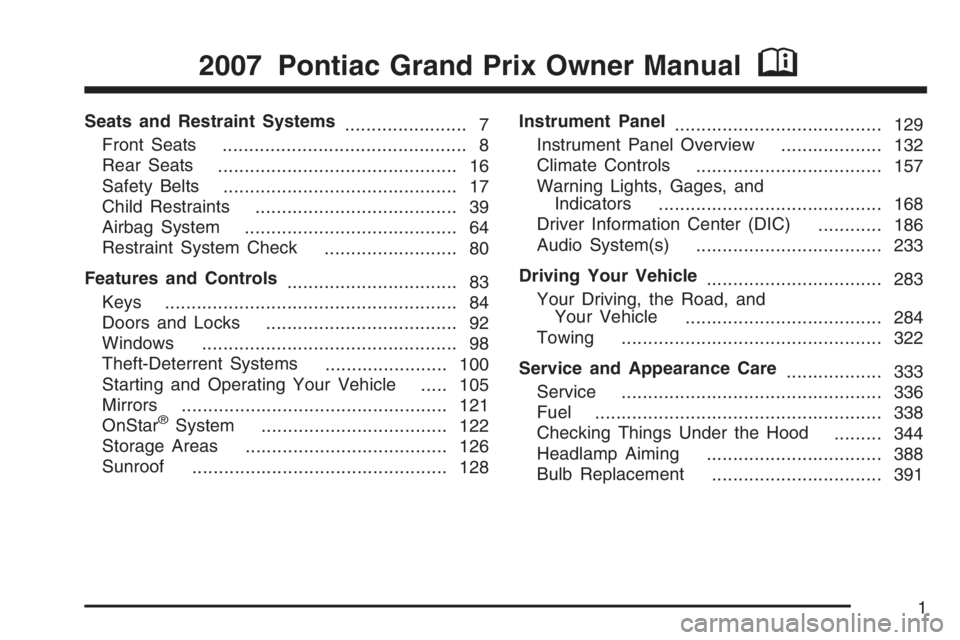
Seats and Restraint Systems
....................... 7
Front Seats
.............................................. 8
Rear Seats
............................................. 16
Safety Belts
............................................ 17
Child Restraints
...................................... 39
Airbag System
........................................ 64
Restraint System Check
......................... 80
Features and Controls
................................ 83
Keys
....................................................... 84
Doors and Locks
.................................... 92
Windows
................................................ 98
Theft-Deterrent Systems
....................... 100
Starting and Operating Your Vehicle
..... 105
Mirrors
.................................................. 121
OnStar
®System
................................... 122
Storage Areas
...................................... 126
Sunroof
................................................ 128Instrument Panel
....................................... 129
Instrument Panel Overview
................... 132
Climate Controls
................................... 157
Warning Lights, Gages, and
Indicators
.......................................... 168
Driver Information Center (DIC)
............ 186
Audio System(s)
................................... 233
Driving Your Vehicle
................................. 283
Your Driving, the Road, and
Your Vehicle
..................................... 284
Towing
................................................. 322
Service and Appearance Care
.................. 333
Service
................................................. 336
Fuel
...................................................... 338
Checking Things Under the Hood
......... 344
Headlamp Aiming
................................. 388
Bulb Replacement
................................ 391
2007 Pontiac Grand Prix Owner ManualM
1
Page 31 of 526

Safety Belt Use During Pregnancy
Safety belts work for everyone, including pregnant
women. Like all occupants, they are more likely
to be seriously injured if they do not wear
safety belts.
A pregnant woman should wear a lap-shoulder
belt, and the lap portion should be worn as low as
possible, below the rounding, throughout the
pregnancy.The best way to protect the fetus is to protect the
mother. When a safety belt is worn properly, it
is more likely that the fetus will not be hurt
in a crash. For pregnant women, as for anyone,
the key to making safety belts effective is wearing
them properly.
Right Front Passenger Position
To learn how to wear the right front passenger’s
safety belt properly, seeDriver Position on page 22.
The right front passenger’s safety belt works the
same way as the driver’s safety belt — except
for one thing. If you ever pull the shoulder portion
of the belt out all the way, you will engage the
child restraint locking feature. If this happens, let
the belt go back all the way and start again.
31
Page 64 of 526
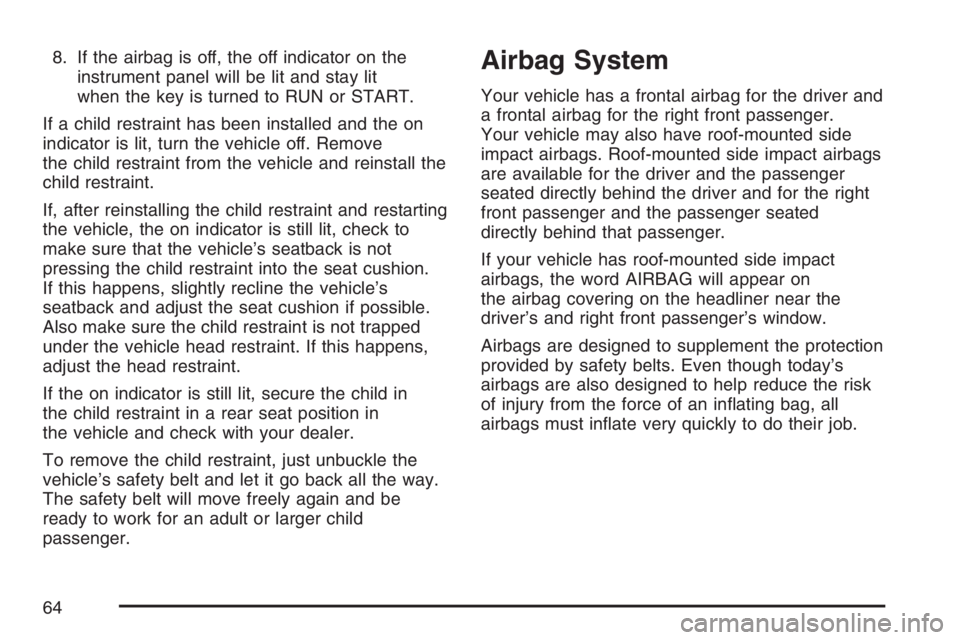
8. If the airbag is off, the off indicator on the
instrument panel will be lit and stay lit
when the key is turned to RUN or START.
If a child restraint has been installed and the on
indicator is lit, turn the vehicle off. Remove
the child restraint from the vehicle and reinstall the
child restraint.
If, after reinstalling the child restraint and restarting
the vehicle, the on indicator is still lit, check to
make sure that the vehicle’s seatback is not
pressing the child restraint into the seat cushion.
If this happens, slightly recline the vehicle’s
seatback and adjust the seat cushion if possible.
Also make sure the child restraint is not trapped
under the vehicle head restraint. If this happens,
adjust the head restraint.
If the on indicator is still lit, secure the child in
the child restraint in a rear seat position in
the vehicle and check with your dealer.
To remove the child restraint, just unbuckle the
vehicle’s safety belt and let it go back all the way.
The safety belt will move freely again and be
ready to work for an adult or larger child
passenger.Airbag System
Your vehicle has a frontal airbag for the driver and
a frontal airbag for the right front passenger.
Your vehicle may also have roof-mounted side
impact airbags. Roof-mounted side impact airbags
are available for the driver and the passenger
seated directly behind the driver and for the right
front passenger and the passenger seated
directly behind that passenger.
If your vehicle has roof-mounted side impact
airbags, the word AIRBAG will appear on
the airbag covering on the headliner near the
driver’s and right front passenger’s window.
Airbags are designed to supplement the protection
provided by safety belts. Even though today’s
airbags are also designed to help reduce the risk
of injury from the force of an in�ating bag, all
airbags must in�ate very quickly to do their job.
64
Page 74 of 526
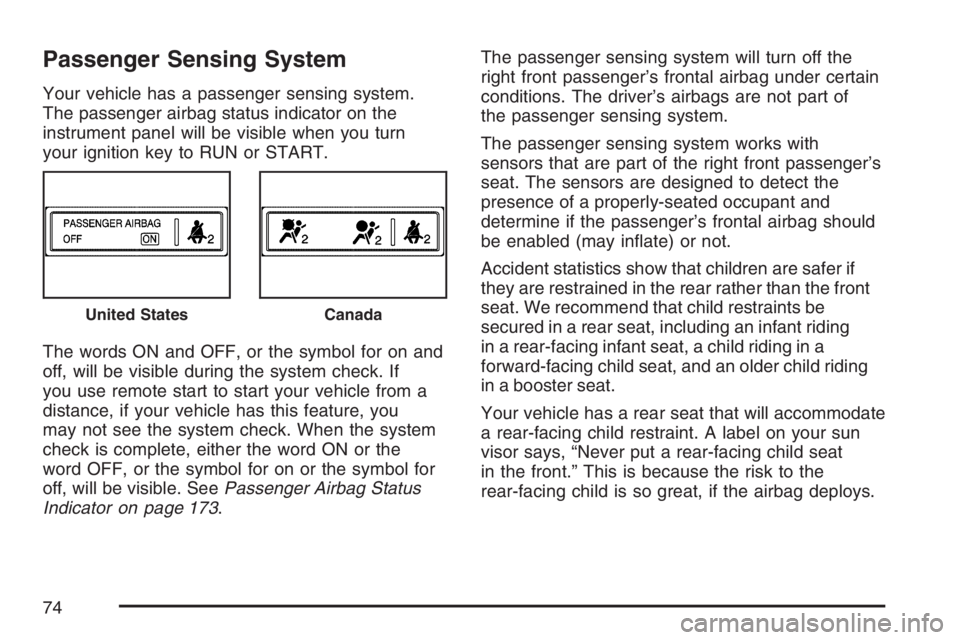
Passenger Sensing System
Your vehicle has a passenger sensing system.
The passenger airbag status indicator on the
instrument panel will be visible when you turn
your ignition key to RUN or START.
The words ON and OFF, or the symbol for on and
off, will be visible during the system check. If
you use remote start to start your vehicle from a
distance, if your vehicle has this feature, you
may not see the system check. When the system
check is complete, either the word ON or the
word OFF, or the symbol for on or the symbol for
off, will be visible. SeePassenger Airbag Status
Indicator on page 173.The passenger sensing system will turn off the
right front passenger’s frontal airbag under certain
conditions. The driver’s airbags are not part of
the passenger sensing system.
The passenger sensing system works with
sensors that are part of the right front passenger’s
seat. The sensors are designed to detect the
presence of a properly-seated occupant and
determine if the passenger’s frontal airbag should
be enabled (may in�ate) or not.
Accident statistics show that children are safer if
they are restrained in the rear rather than the front
seat. We recommend that child restraints be
secured in a rear seat, including an infant riding
in a rear-facing infant seat, a child riding in a
forward-facing child seat, and an older child riding
in a booster seat.
Your vehicle has a rear seat that will accommodate
a rear-facing child restraint. A label on your sun
visor says, “Never put a rear-facing child seat
in the front.” This is because the risk to the
rear-facing child is so great, if the airbag deploys.
United StatesCanada
74
Page 83 of 526

Keys.............................................................. 84
Remote Keyless Entry (RKE) System.......... 86
Remote Keyless Entry (RKE) System
Operation................................................. 87
Doors and Locks.......................................... 92
Door Locks................................................. 92
Power Door Locks....................................... 94
Delayed Locking.......................................... 94
Programmable Automatic Door Locks.......... 95
Rear Door Security Locks........................... 95
Lockout Protection....................................... 96
Trunk.......................................................... 96
Windows....................................................... 98
Power Windows.......................................... 99
Sun Visors................................................ 100
Theft-Deterrent Systems............................. 100
Content Theft-Deterrent............................. 100
PASS-Key
®III ........................................... 102
PASS-Key®III Operation........................... 103
Starting and Operating Your Vehicle......... 105
New Vehicle Break-In................................ 105
Ignition Positions....................................... 105
Retained Accessory Power (RAP)............. 106
Starting the Engine.................................... 107Engine Coolant Heater.............................. 108
Active Fuel Management™........................ 109
Automatic Transaxle Operation.................. 110
Parking Brake........................................... 115
Shifting Into Park (P) ................................. 116
Shifting Out of Park (P)............................. 117
Parking Over Things That Burn................. 118
Engine Exhaust......................................... 119
Running the Engine While Parked............. 120
Mirrors......................................................... 121
Manual Rearview Mirror with OnStar
®....... 121
Outside Power Mirrors............................... 121
Outside Convex Mirror............................... 122
OnStar
®System.......................................... 122
Storage Areas............................................. 126
Glove Box................................................. 126
Cupholder(s).............................................. 126
Sunglasses Storage Compartment............. 127
Front Seat Storage Net............................. 127
Center Console Storage Area.................... 127
Assist Handles.......................................... 127
Convenience Net....................................... 127
Sunroof....................................................... 128
Section 2 Features and Controls
83
Page 84 of 526

Keys
{CAUTION:
Leaving children in a vehicle with the
ignition key is dangerous for many
reasons. They could operate the power
windows or other controls or even make
the vehicle move. The children or others
could be badly injured or even killed.
Do not leave the keys in a vehicle with
children.
84
Page 85 of 526
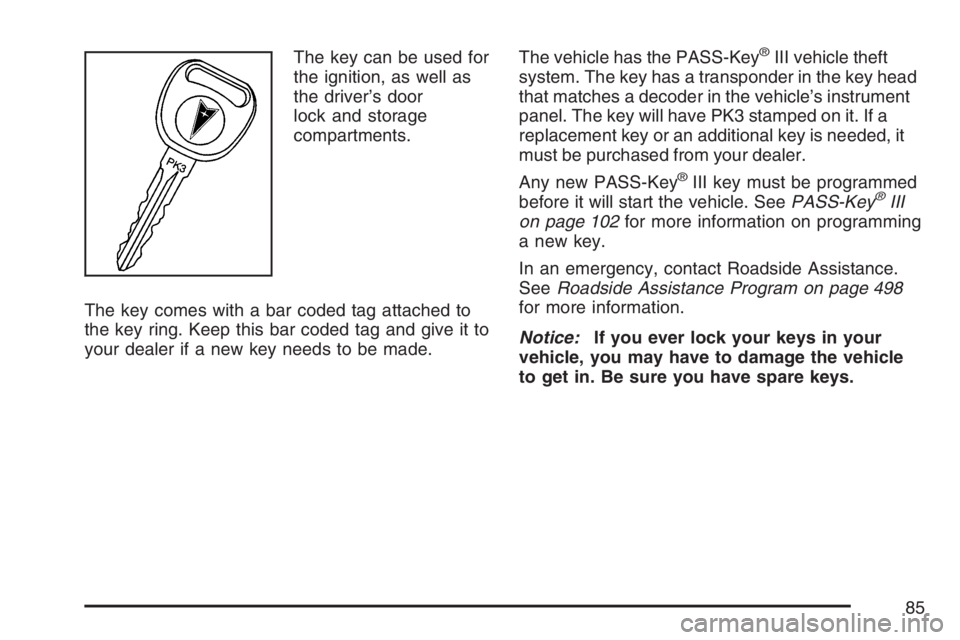
The key can be used for
the ignition, as well as
the driver’s door
lock and storage
compartments.
The key comes with a bar coded tag attached to
the key ring. Keep this bar coded tag and give it to
your dealer if a new key needs to be made.The vehicle has the PASS-Key®III vehicle theft
system. The key has a transponder in the key head
that matches a decoder in the vehicle’s instrument
panel. The key will have PK3 stamped on it. If a
replacement key or an additional key is needed, it
must be purchased from your dealer.
Any new PASS-Key
®III key must be programmed
before it will start the vehicle. SeePASS-Key®III
on page 102for more information on programming
a new key.
In an emergency, contact Roadside Assistance.
SeeRoadside Assistance Program on page 498
for more information.
Notice:If you ever lock your keys in your
vehicle, you may have to damage the vehicle
to get in. Be sure you have spare keys.
85
Page 86 of 526
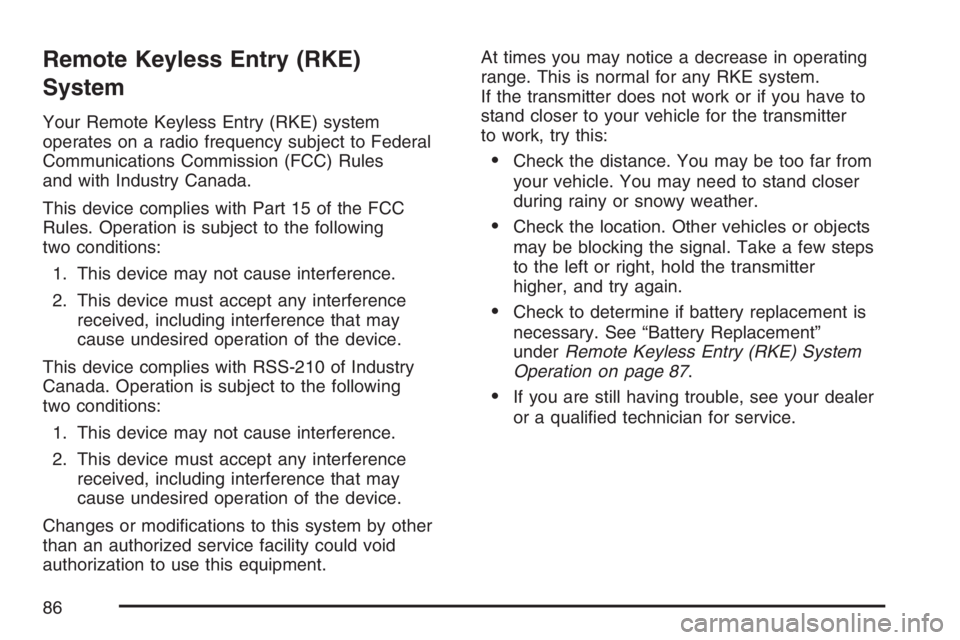
Remote Keyless Entry (RKE)
System
Your Remote Keyless Entry (RKE) system
operates on a radio frequency subject to Federal
Communications Commission (FCC) Rules
and with Industry Canada.
This device complies with Part 15 of the FCC
Rules. Operation is subject to the following
two conditions:
1. This device may not cause interference.
2. This device must accept any interference
received, including interference that may
cause undesired operation of the device.
This device complies with RSS-210 of Industry
Canada. Operation is subject to the following
two conditions:
1. This device may not cause interference.
2. This device must accept any interference
received, including interference that may
cause undesired operation of the device.
Changes or modi�cations to this system by other
than an authorized service facility could void
authorization to use this equipment.At times you may notice a decrease in operating
range. This is normal for any RKE system.
If the transmitter does not work or if you have to
stand closer to your vehicle for the transmitter
to work, try this:
Check the distance. You may be too far from
your vehicle. You may need to stand closer
during rainy or snowy weather.
Check the location. Other vehicles or objects
may be blocking the signal. Take a few steps
to the left or right, hold the transmitter
higher, and try again.
Check to determine if battery replacement is
necessary. See “Battery Replacement”
underRemote Keyless Entry (RKE) System
Operation on page 87.
If you are still having trouble, see your dealer
or a quali�ed technician for service.
86
Page 87 of 526
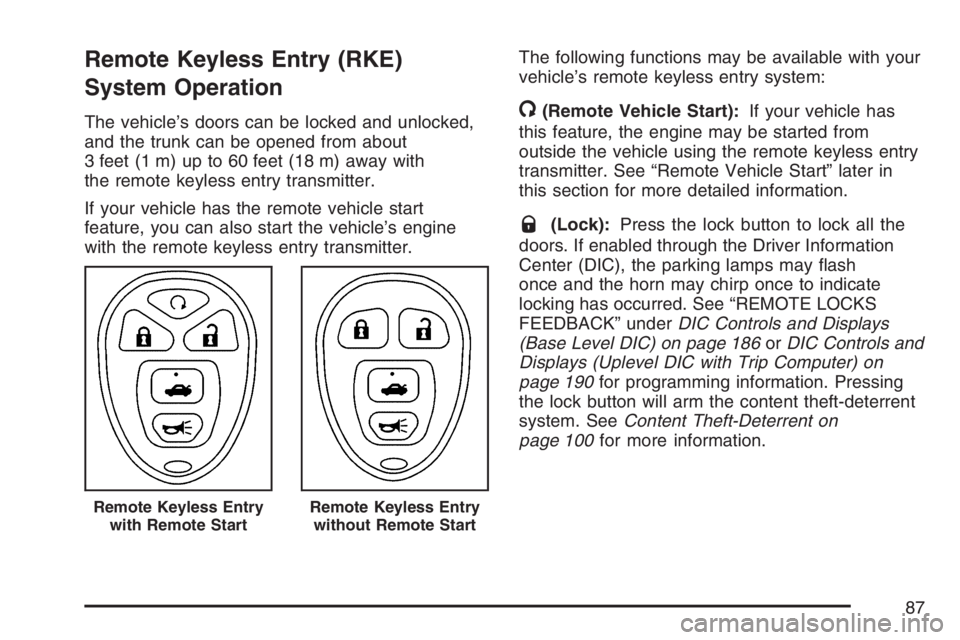
Remote Keyless Entry (RKE)
System Operation
The vehicle’s doors can be locked and unlocked,
and the trunk can be opened from about
3 feet (1 m) up to 60 feet (18 m) away with
the remote keyless entry transmitter.
If your vehicle has the remote vehicle start
feature, you can also start the vehicle’s engine
with the remote keyless entry transmitter.The following functions may be available with your
vehicle’s remote keyless entry system:/(Remote Vehicle Start):If your vehicle has
this feature, the engine may be started from
outside the vehicle using the remote keyless entry
transmitter. See “Remote Vehicle Start” later in
this section for more detailed information.
Q(Lock):Press the lock button to lock all the
doors. If enabled through the Driver Information
Center (DIC), the parking lamps may �ash
once and the horn may chirp once to indicate
locking has occurred. See “REMOTE LOCKS
FEEDBACK” underDIC Controls and Displays
(Base Level DIC) on page 186orDIC Controls and
Displays (Uplevel DIC with Trip Computer) on
page 190for programming information. Pressing
the lock button will arm the content theft-deterrent
system. SeeContent Theft-Deterrent on
page 100for more information.
Remote Keyless Entry
with Remote StartRemote Keyless Entry
without Remote Start
87
Page 88 of 526
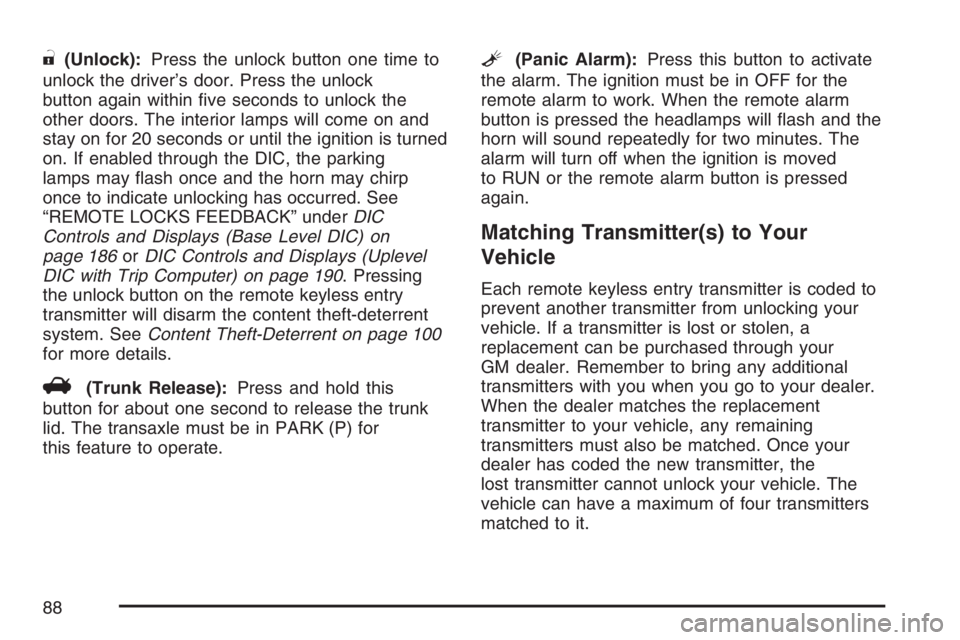
"(Unlock):Press the unlock button one time to
unlock the driver’s door. Press the unlock
button again within �ve seconds to unlock the
other doors. The interior lamps will come on and
stay on for 20 seconds or until the ignition is turned
on. If enabled through the DIC, the parking
lamps may �ash once and the horn may chirp
once to indicate unlocking has occurred. See
“REMOTE LOCKS FEEDBACK” underDIC
Controls and Displays (Base Level DIC) on
page 186orDIC Controls and Displays (Uplevel
DIC with Trip Computer) on page 190. Pressing
the unlock button on the remote keyless entry
transmitter will disarm the content theft-deterrent
system. SeeContent Theft-Deterrent on page 100
for more details.
V(Trunk Release):Press and hold this
button for about one second to release the trunk
lid. The transaxle must be in PARK (P) for
this feature to operate.
L(Panic Alarm):Press this button to activate
the alarm. The ignition must be in OFF for the
remote alarm to work. When the remote alarm
button is pressed the headlamps will �ash and the
horn will sound repeatedly for two minutes. The
alarm will turn off when the ignition is moved
to RUN or the remote alarm button is pressed
again.
Matching Transmitter(s) to Your
Vehicle
Each remote keyless entry transmitter is coded to
prevent another transmitter from unlocking your
vehicle. If a transmitter is lost or stolen, a
replacement can be purchased through your
GM dealer. Remember to bring any additional
transmitters with you when you go to your dealer.
When the dealer matches the replacement
transmitter to your vehicle, any remaining
transmitters must also be matched. Once your
dealer has coded the new transmitter, the
lost transmitter cannot unlock your vehicle. The
vehicle can have a maximum of four transmitters
matched to it.
88